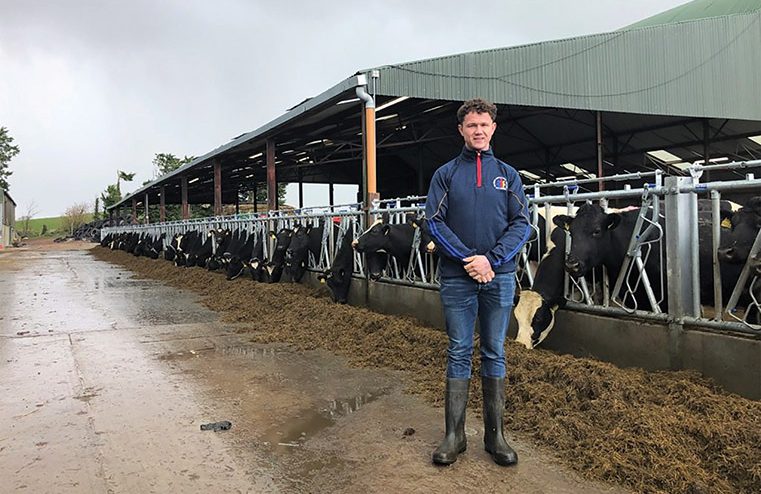
The Salesian Agricultural College in Pallaskenry, Co Limerick runs a fully commercial farm to support its teaching. Since last September, there has been a new farm manager as Brendan Ryan took on the role.
Despite being in the position less than year, Brendan has already overseen many changes to the farm as they look at more efficient ways of carrying out their daily duties.
Farming has always been a massive part of our heritage and it will remain to be for many generations to come. Technology plays a massive part in agriculture and this is an area that has been embraced by Brendan and his team at the college.
Owned by the Salesian of Don Bosco, the Salesian Agricultural College, Pallaskenry is involved in the delivery of the Teagasc educational programme and is one of the leading agricultural colleges in the Munster region.
Located about 16km from Limerick city, the college is situated along the Shannon estuary where 210 hectares of land is farmed. The Salesian Agricultural College offers courses in both agriculture and farm machinery/mechanisation.
Courses are run in conjunction with Teagasc and Limerick Institute of Technology, being QQI accredited, with all aspects of farming covered by the college.
Pallaskenry has excellent teaching and recreational facilities. An Information Technology Centre contains state of the art computers with WiFi enabled access throughout the campus.
There are also a range of engineering/machinery workshops to facilitate the delivery of the colleges specialised machinery programmes.
The Salesian College is also the home to the local secondary where 730 students attend, while in the region of 550 attend the agricultural college.
“We have the students involved in working on the farm, this is in addition to their practicals. They are put on rota, so they all get a chance to work here,” said Brendan.
The abolition of the milk quota a few years back has allowed the Salesian Agriculture College expand their dairy herd and they are now milking 400 cows with the aim to increase that to 440 next year.
“We are in the process of constructing a new 50-bale rotary dairy parlour and collecting site while a new 252 cubicle shed was constructed earlier in the year,” said Brendan.
The new parlour will include a feed-to-yield system; milk meters; variable speed rotation (speeds up and slows down depending on the time of year; a robotic teat spraying arm; auto-identification; cluster flush; and many more features.
The Farm Manager revealed that the new milking parlour will greatly reduce milking times, as it currently stands at three hours, but in the new system that time will greatly reduced.
“At present, we have a farm relief milker coming in to help out with the milking. He does two hours in the morning and two hours in the evening, but one of the lads takes over, just to break it up. With the new parlour, milking will only take an hour and a half, which is great.
“This also gives us the opportunity to focus on other jobs that needs doing and it creates a lot of extra man power during the week.”
Pallaskenry has gone from a high input system to a grass based system of milk production, with major changes made to the herd and their way of farming.
“The herd itself has changed in that we were a high-yielding pedigree Holstein herd, but now the cattle comprise of high-EBI Holstein-Friesian grass-based herd.”
To cope with the ever-increasing herd, Brendan and his staff of two, farm 500 acres of land with the majority of that within walking distance of the college.
“About 70% of the land would be within walking distance of the yard here. The majority of it is good dry land, some of it which is on the banks of the Shannon would be heavy enough though.”
Pallaskenry is not just about dairy farming as they also have 65 ewes, 32 sucklers and 60 calf to beef. “We are looking to have a more productive animal and this year I sourced 88 new heifers which were bought in Kildare and Meath.”
Brendan added that the aim was to supply two million litres of milk this year and he revealed that they were well on target to do so.
“By early June, we had already supplied one million litres, but the yield will drop as the year goes on.”
A contract rearer in Co Roscommon was used to rear the first 100 Friesian heifer calves born and Brendan is delighted with the way they have progressed.
“The Friesian bull calves sold for €20/calf across the board and any Jersey calves are going for free, all to one beef rearer. The beef rearer brings back figures when he sell the finished beef, and we agreed what we get after that – whether it’s €10/calf or whatever.
“Last year, the herd supplied 5,300L/cow and 452kg of MS/cow at 4.56% fat and 3.74% protein – with an average SCC of 94,000. This was met with 790kg of meal fed per cow.”
There have been considerable changes made to the farm in recent times and an enthusiastic Brendan stressed that this was just the beginning.
“There are big plans going forward. There is a major investment being put into the farm at the moment with the new cubicle shed and the milking parlour, while a 1.3km roadway has also been constructed.
“The herd is being increased on an annual basis and the aim is to increase productivity. We are happy with the direction we are going, even though this year has been testing to say the least.”
Contact Details:
Pallaskenry Agricultural College
Pallaskenry,
Co. Limerick
Tel: (061) 393100
Fax: (061) 393005
Email: [email protected]
First published in Irish Tractor & Agri magazine Vol 8 No 3, October/November 2020
Pallaskenry Agricultural College